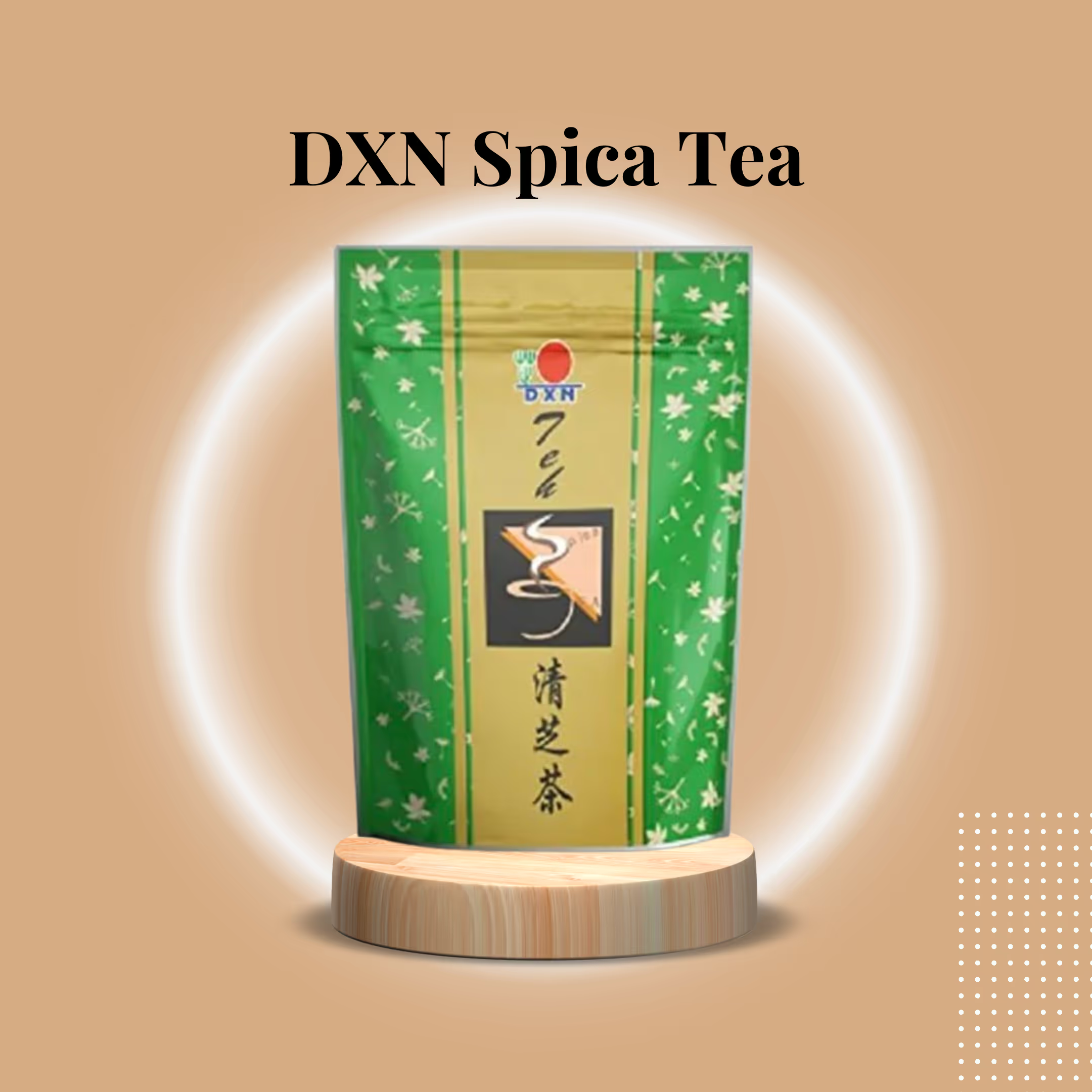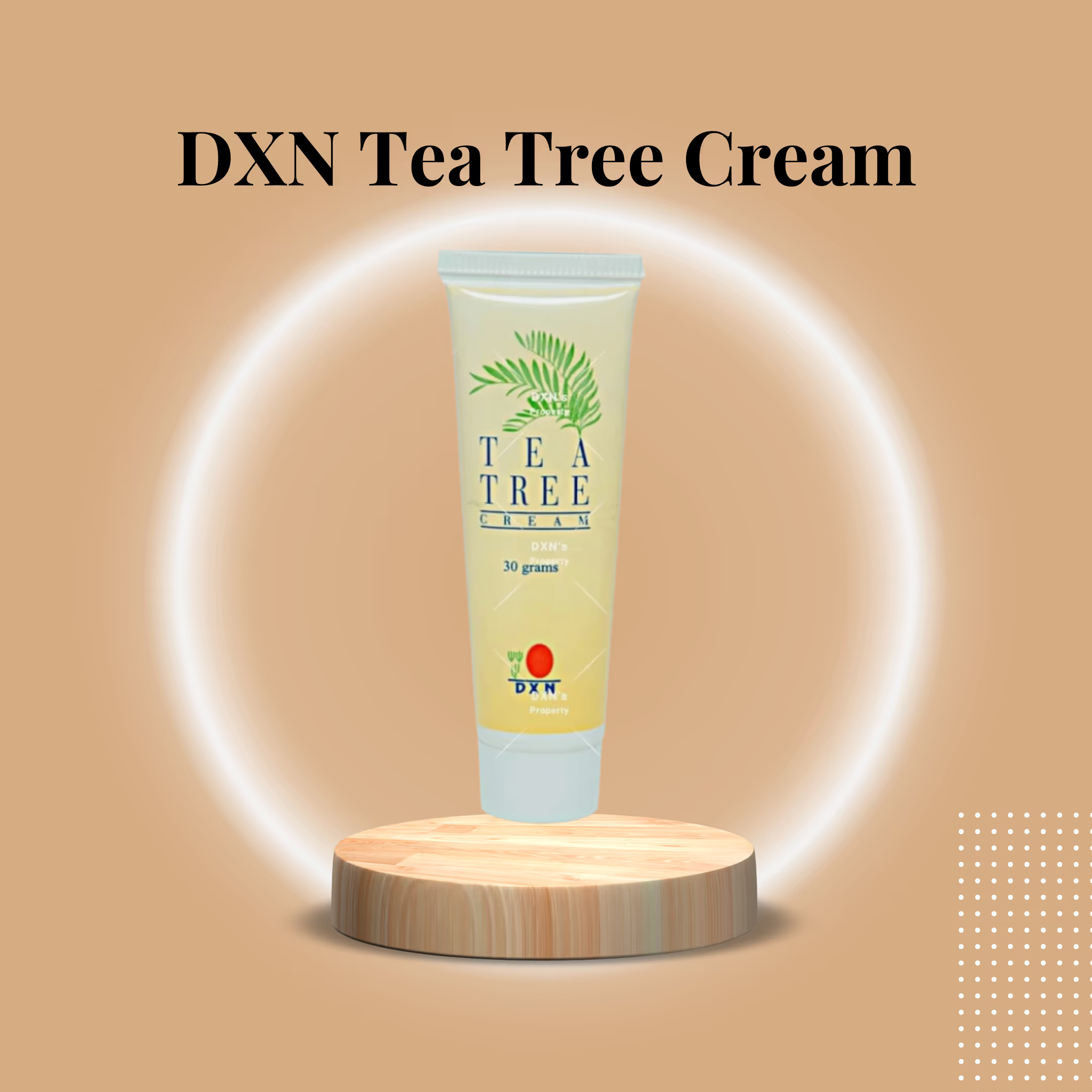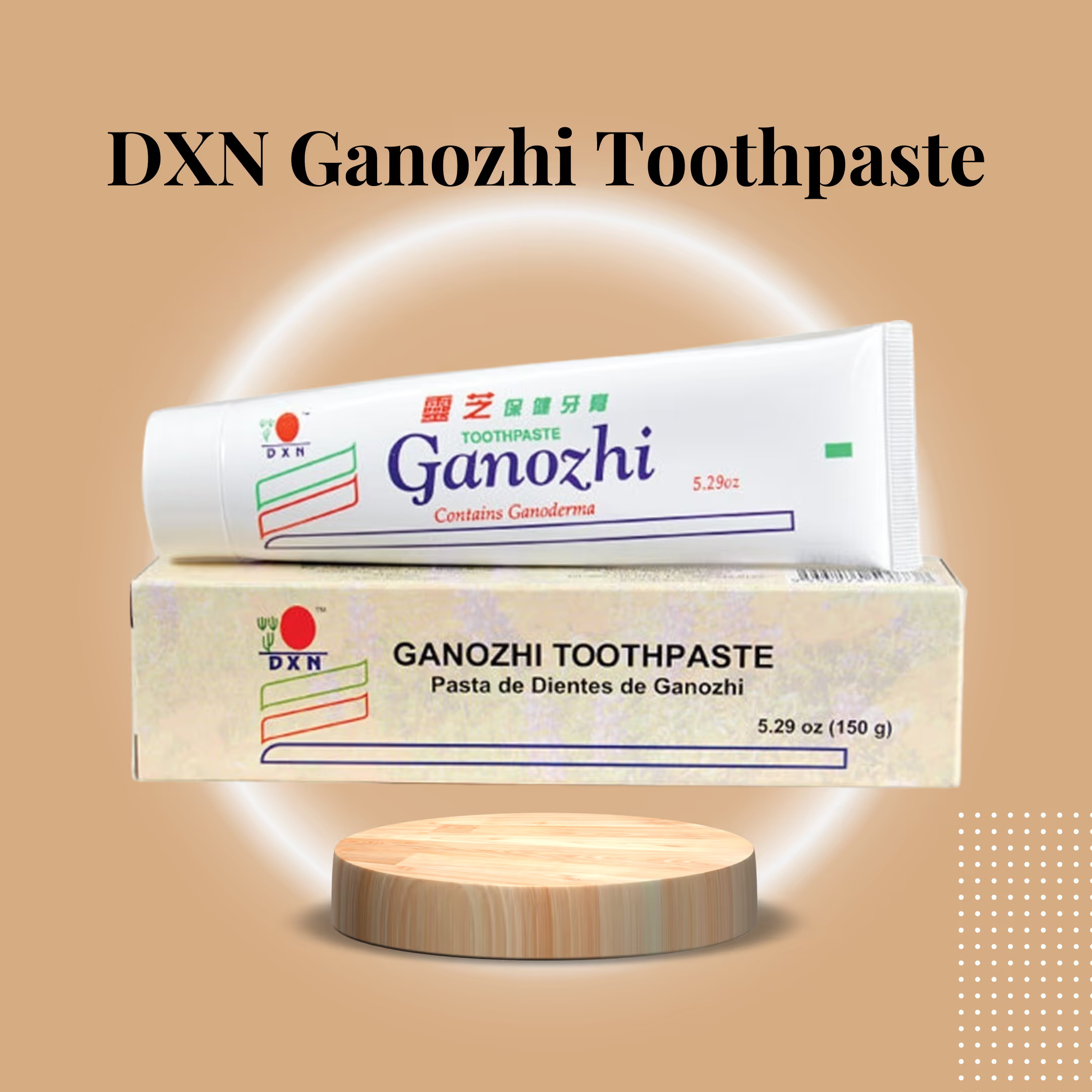1. What is DXN Spica Tea? A friendly overview
DXN Spica Tea is a thoughtfully formulated herbal drink built around five key plants: Ganoderma lucidum (Reishi, a type of mushroom), Spica prunellae (Selfheal, a small flowering herb), Radix glycyrrhizae (licorice root), Pericarpium citri reticulatae (tangerine peel), and Herba menthae (peppermint). Unlike more common teas made from the Camellia sinensis plant (such as black, green, or oolong tea), Spica contains no tea leaves and is caffeine-free. This makes it suitable for drinking later in the day or for people who avoid caffeine and other stimulants.
Its design follows traditional herbal principles, particularly those of Traditional Chinese Medicine (TCM), which emphasize balance and synergy. Each botanical has a purpose: Reishi offers adaptogenic and immune support; Selfheal provides cooling, anti-inflammatory effects; licorice harmonizes while soothing mucous membranes; tangerine peel aids digestion and clears dampness; peppermint refreshes and helps digestion and breathing. This recipe targets three pillars: immune resilience, digestive comfort, and respiratory ease—all in a mild, pleasant cup.
2. The five hero botanicals — what each contributes
Ganoderma lucidum (Reishi) — the adaptogen anchor
Reishi has a long history in East Asia as a tonic herb. Research indicates that polysaccharides and triterpenoids are key bioactive compounds that support immune modulation, antioxidant activity, and stress resilience. Reishi in Spica serves as the adaptogenic base, helping the body maintain balance under stress without stimulation. Regular, modest intake may help support overall resilience and recovery.
Spica prunellae (Selfheal) — the “heat-clearing” specialist
Selfheal is traditionally used to address issues related to excess internal heat or inflammation. Studies have shown that it contains flavonoids and triterpenoids with anti-inflammatory and antimicrobial properties. Spica prunellae helps soothe sore throats, reduce mild inflammation, and support the immune system without harshness.
Radix Glycyrrhizae (Licorice root) — the harmonizer and soother
Licorice is both functional and palatable: its sweetness improves taste, and its compounds (notably glycyrrhizin) have anti-inflammatory, antioxidant, and demulcent effects. In herbalism, it “harmonizes” formulas—smoothing effects and supporting the stomach and respiratory tract. Note: Large amounts of glycyrrhizin can affect blood pressure and electrolyte levels, as discussed in the safety section.
Pericarpium Citri Reticulatae (Tangerine peel) — digestion and aroma
Tangerine peel adds aroma and action. Traditionally, it regulates Qi and supports digestion. It can help ease bloating and support bile flow to aid in fat digestion, thereby relieving mild post-meal discomfort. Its citrus scent also enhances the tea’s appeal.
Herba Menthae (Peppermint) — cool, refreshing digestive aid
Peppermint brings a cool note and acts as a mild decongestant and digestive tonic. Menthol soothes the stomach, relaxes smooth muscle, and supports nasal comfort by increasing airflow perception.
Together, these ingredients create a balanced formula: Reishi for systemic tone, Selfheal and licorice for their cooling and soothing properties, tangerine for digestive support, and peppermint for refreshing comfort.
3. How Spica Tea works — simple mechanisms you can feel
Herbal mixtures usually don't act like single-ingredient medicines. Instead, they work through several complementary pathways:
- Immune modulation and antioxidant support: Reishi’s polysaccharides interact with immune cells for balanced responses. Licorice and other herbs contain antioxidants that help manage oxidative stress, a key driver of inflammation. Over time, this combination helps the immune system respond efficiently.
- Anti-inflammatory action: Compounds in Selfheal and licorice show anti-inflammatory activity. That helps reduce low-grade inflammation, which can manifest as “heatiness,” a sore throat, skin irritation, or digestive discomfort.
- Digestive regulation: Tangerine peel stimulates digestive secretions and peristalsis, while peppermint relaxes gut muscles to reduce cramps and bloating. The aroma also stimulates salivary and gastric secretions, promoting better digestion.
- Respiratory support: Peppermint works as a light expectorant (helps clear mucus) and decongestant (relieves stuffiness); licorice soothes the moist linings (mucous membranes) in your throat and nose, bringing comfort during mild seasonal issues.
Since Spica Tea is caffeine-free, its effects are not based on stimulation. You won’t get a “jolt”—benefits build through regular use and by supporting natural processes.
4. Who benefits most from DXN Spica Tea?
Spica Tea is especially suitable for:
- People who want a caffeine-free functional beverage for evenings or for those sensitive to stimulants.
- Individuals seeking mild immune support during seasons of increased exposure.
- Those with occasional digestive discomfort (bloating, slow digestion) who prefer botanical approaches.
- Anyone wanting a calming, restorative ritual at the end of the day — a cup that supports sleep readiness rather than wakes you up.
- Consumers seeking a gentle respiratory comfort option for mild congestion or after exposure to smoky/dry environments.
It’s not a cure for infections or chronic disease—think of it as a daily tonic that supports balance and comfort.
5. Practical benefits: what to expect with regular use
When people integrate Spica Tea into their routine, common reports include:
- Reduced post-meal bloating and better digestion, especially when the tea is used as a pre-meal or post-meal tonic.
- Gentler seasonal comfort — milder throat irritation and reduced mucus complaints, thanks to peppermint and licorice.
- A calming evening ritual that supports relaxation without caffeine interference.
- A subtle sense of improved resilience over weeks of consistent use due to Reishi’s adaptogenic properties.
Keep expectations realistic: herbal tonics work cumulatively. Effects appear with regular use and healthy lifestyle habits (diet, sleep, hydration).
6. Preparation, timing, and serving ideas — how to get the most from your cup
Classic brew: Use one Spica Tea sachet or one heaped teaspoon of loose blend per 200–250 ml boiling water. Steep 3–5 minutes. Strain and sip warm. Adjust steeping for flavor strength.
Timing strategies:
- Morning: Start your day with a cup for a gentle start and to prime your digestion.
- Pre-meal or post-meal: Drink 15–30 minutes before meals to support digestion; or 20–40 minutes after a heavy meal for comfort and motility.
- Evening: Drink 30–60 minutes before bed for a caffeine-free, relaxing effect.
Cold brew/iced: Brew hot, cool, and chill for iced tea. Add a squeeze of lemon (unless sensitive to acidity) or a teaspoon of honey (if desired).
Pairings: Light meals such as salads, steamed vegetables, or fish.
- After meals: Try fermented foods like yogurt or kimchi for gut support.
- With other DXN products: Pairs with stimulant products like DXN coffee. Spica is the evening complement in a day-long routine.
7. Safety, contraindications, and sensible cautions
Spica Tea is mild, but a few responsible cautions apply:
Licorice and blood pressure
Licorice root contains glycyrrhizin, which may affect blood pressure and potassium levels when consumed in large amounts or over long periods. In Spica Tea, licorice is present as part of a balanced blend, so moderate, occasional use is generally suitable for most people. For individuals with high blood pressure, heart conditions, or electrolyte imbalances, or those using medications that affect these factors (such as diuretics), it's best to consult a healthcare provider before making Spica Tea a daily habit.
Pregnancy & breastfeeding
If you are pregnant or breastfeeding, talk with your healthcare provider before enjoying herbal blends like Spica Tea regularly. Herbs can interact with your body's needs during these times, and personalized advice helps ensure your comfort and safety.
Drug interactions
Herbal compounds can interact with drugs. Reishi may alter immune function; licorice can impact blood pressure and corticosteroid levels. If you’re on immunosuppressants, anticoagulants, blood pressure meds, or other chronic drugs, check with your prescriber.
Allergies & sensitivities
Avoid Spica if you have a known allergy to mushrooms (including Reishi) or any listed herb. Peppermint can trigger heartburn in some individuals who are sensitive to it. Sugar-free sweeteners (if used in flavored blends) can cause digestive upset in very high amounts.
Children
Herbal teas are commonly used with older children, but lozenges and potent medicines aren’t appropriate for very young children. For kids, consult a pediatrician.
In short, Spica Tea is generally safe for most healthy adults when used as recommended; however, individuals with specific health conditions or those taking medications should consult a healthcare professional.
8. Evidence and realistic expectations
There is growing scientific literature on the individual botanicals used in Spica Tea: Reishi’s polysaccharides and triterpenoids, selfheal’s flavonoids, licorice’s glycyrrhizin, and peppermint’s menthol. Evidence supports the immune-modulating, anti-inflammatory, digestive comfort, and antioxidant properties of the blend's components. However, herbal tea is not a pharmaceutical; benefits are generally modest, cumulative, and best experienced as part of an overall healthy lifestyle.
If you expect immediate, dramatic cures, you’ll be disappointed. If you incorporate Spica Tea into a balanced routine (including diet, sleep, and stress management), you’re likely to notice practical and pleasant benefits: gentler digestion, calmer evenings, and a supportive daily ritual that contributes to long-term resilience.
9. How Spica Tea compares to other DXN beverages
DXN offers a range of products infused with Ganoderma. Spica Tea occupies the niche of caffeine-free, targeted relief. Contrast:
- DXN Lingzhi Coffee — a caffeinated blend for morning energy with adaptogenic support. Not for evening use.
- DXN Reishi Gano Tea — tea leaf base with Reishi, general antioxidant tonic; may contain small amounts of caffeine depending on leaf mix.
- DXN Spica Tea — entirely herbal, no caffeine, aimed at digestion, respiratory comfort, and “heat-clearing.”
Choosing depends on your needs: do you want energy and an adaptogen? Choose coffee in the morning. Want evening balance and digestive/respiratory support? Spica is the better fit.
10. Quality, sourcing, and authenticity
When purchasing any herbal product, look for transparency from the manufacturer: clear ingredient lists, adherence to production standards, third-party testing for contaminants, and authorized distribution channels to avoid counterfeit goods. Genuine Spica Tea should be clearly labeled, caffeine-free, and packaged to preserve freshness.
11. Lifestyle integration: building a simple Spica ritual
Here’s a practical one-week starter plan:
- Day 1–2: Brew one cup after dinner — notice any changes in sleep and digestion.
- Day 3–4: Try a cup 20 minutes before a light lunch and note any reduction in bloating.
- Days 5–7: Make the evening cup a ritual — dim the lights, breathe, and sip slowly. Reflect on cumulative changes: mood, digestion, sleep quality.
This ritualistic aspect is part of the product’s value: a small habit that signals rest and recovery to your nervous system.
12. Sustainability and storage
Store in a cool, dry place away from direct sunlight. If packaged in single-use sachets, ensure proper disposal or recycling according to local rules. If you buy loose-leaf tea, store it in an airtight container to preserve its volatile aromatics.
.avif)





